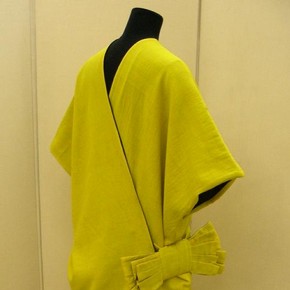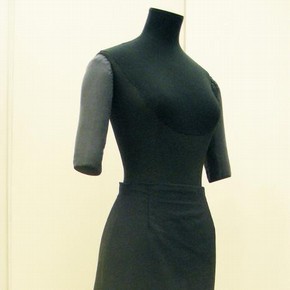Conservation Journal
Spring 2012 Issue 60
Utilising skills and creating opportunities
Michelle Jensen
Conservation Administrator
The current economic climate has placed increasing demands on the museum sector to maintain work standards and deliver exhibition programmes without taking on extra staff and resources. Sandra Smith, Head of Conservation, developed a skills matrix to obtain an overview of current skills within the Department, highlighting where staff have previous training and experience that goes beyond their chosen specialism or job description.
In my usual role as conservation administrator, I provide admin support across the whole Department. This has given me the opportunity to talk to conservators about current projects and about my own interest in sewing. It also meant that my colleagues in textiles conservation became aware of the type of help I could provide.
Assisting the textile conservation studio with exhibition de-installation and making soft packing rolls for flat textiles enabled me to demonstrate my sewing and general hand skills. This led to a short secondment to textile conservation, making soft packing for the Wedding Dresses exhibition. I then had a further two-month secondment for two days a week, costume mounting for a loan of costumes by Paul Poiret for an exhibition at the Kremlin. The workload within textiles conservation at this time meant that this loan could not have been taken on without extra help in mounting the costumes. Rather than bringing in extra contract staff or turning down the loan, it was decided that my skills could be utilised and developed further.
The outstanding level of teamwork within the studio meant that I received the necessary support and and on-the-job training. The Museum’s costume mounters are allocated work on exhibitions, loans and displays but also retain a flexible approach to their workload, providing assistance to each other when object handling requires more than one person, or when advice or skills sharing is needed to solve costume-mounting problems.
Some of the specialist skills that I learned during my secondment included:
- How to strip back the calico cover and make size adjustments to the mannequin
- How to build up layers of wadding in the required areas to better fit the costume being mounted
- How to sew a fitted cover in stretch jersey, add arms and an underskirt to the mannequin for display
- How to make adjustments to the mount that help show the costume in its best light.
There are advantages to utilising existing skills within the Department, rather than offering temporary contracts. As I am already familiar with the Museum’s procedures, the time I spent in Textile Conservation could be devoted solely to practical work rather than having to take part in the staff induction process. It also means that the Museum retains my skills in-house and can call on them should assistance be required for future projects.
Acknowledgements
I would like to thank Sandra Smith and Marion Kite for offering me the secondment and the costume mounting team for their training and support.
Spring 2012 Issue 60
- Editorial
- Mahasiddha Virupa: an exploration
- Science Section supports the Public Programme
- REMAI: the European Network of Museums of Islamic Art
- Positive Negative
- Cutting character: research into innovative mannequin costume supports in collaboration with the Royal College of Art Rapid Form Department
- The Alhambra Court fire surround
- Moving Meleager
- Utilising skills and creating opportunities
- Preserving intangible integrity
- Re-housing alabasters: an altarpiece framework mount
- Cinderella table
- Bombay Blackwood
- Punch and Bunny: conservation of a pop-up theatre book
- The technical examination and conservation treatment of Portrait of a Lady by Francesco Morandini
- Conservation of a child’s fairy costume
- Conservation 'on a roll'
- Editorial board & Disclaimer

